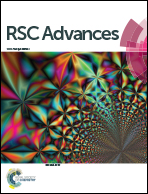Novel valproic aminophenol amides with enhanced glial cell viability effect†
Abstract
New valproic acid derivatives were synthesized by coupling valproyl chloride with ortho-aminophenols, resulting in seven N-(ortho-hydroxyphenyl)valproamides. These amides share similar structural characteristics and exhibit tuneable electronic and steric contributions either without particular substituents, or through the inclusion of electro-donating (–Me), electro-withdrawing (–NO2) or pi electro-donating/sigma electro-withdrawing (–Cl) substituents at the aromatic ring. The identity of such derivatives was evidenced through spectroscopic characterization using FTIR, 1H, 13C and HETCOR NMR, as well as by analyzing their melting points. In particular, for three derivatives it was feasible to determine their chemical structures in the crystal phase; all three behaved in a similar fashion and exhibited very similar conformations independent of the attached substituents. The base compound was found to exhibit 15.8 times more activity in C6 cells and 4.4 times more activity in U373 cells compared with VPA. In general, the parent compound, or those having –Me as a substituent, presented a greater effect on C6 cells than U373 cells. However, those with –NO2 and –Cl substituents, as well as VPA, required similar doses for the IC50 in both cell lines. Modification of the base compound with a –Me or –NO2 substituent increased the effect on cell viability to ca. 20 times that of VPA in both C6 and U373, indicating that a larger structure causes an important enhancement in the inhibition of cell viability. In both cell lines, –Cl containing derivatives were the most active compounds. For these derivatives, an activity increase of ca. 59 and 47 times that of VPA was observed for C6 and U373 cells, respectively. An important perspective is that VPA analogues possessing an aromatic ring with a –Cl substituent may become central structures in the search for more potent pharmaceutical prototypes.



 Please wait while we load your content...
Please wait while we load your content...